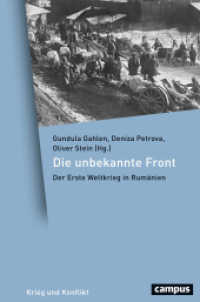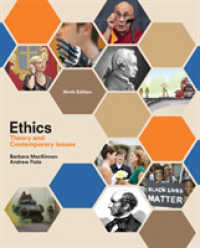Full Description
Presenting new scholarship, this publication is an innovative technical study of the Concrete art movement in Argentina, Brazil, and Uruguay from the 1940s to the 1960s.;;
Purity Is a Myth presents new scholarship on Concrete art in Argentina, Brazil, and Uruguay from the 1940s to the 1960s. Originally coined by the Dutch artist Theo van Doesburg in 1930, the term concrete denotes abstract painting with no reference to external reality. Van Doesburg argued that there was nothing more real than a line, color, or plane. Artists such as Willys de Castro, Lygia Clark, Waldemar Cordeiro, Hermelindo Fiaminghi, Judith Lauand, Raúl Lozza, Tomás Maldonado, Hélio Oiticica, and Rhod Rothfuss would reinvent this concept in postwar Latin America.;;
Drawing on research conducted by Getty and international partners, the essays in this volume address a variety of topics, including the general history, emergence, and reception of Concrete art; processes and color; scientific analysis of works; illustrated chronologies of the paint industry in Brazil and Argentina; and Concrete design on paper. An innovative technical study of the Concrete art movement in Latin America, this volume will be indispensable to scholars, practitioners, and students of Latin American art.
Contents
Acknowledgements
Introduction Zanna Gilbert, Pia Gottschaller, Tom Learner, and Andrew Perchuk The Myth of Purity: New Material Histories of
Concrete Art
1. New perspectives on the emergence of Concrete art from Argentina and Brazil
Niko Vicario (Amherst College) Material Relations: Torres-Garcia and Concrete Art from Argentina
Maria Amalia Garcia (Conicet)
Rhod Rothfuss y el marco recortado. Sintesis de tradiciones de la cultura rioplatense
Heloisa Espada (Instituto Moreira Salles)
Waldemar Cordeiro e o Grupo Forma: a via romana da arte concreta paulista
2. Generative Processes in Concrete Art
Irene Small (Princeton University) Cut, Fuse, Fissure: Planarity circa 1954
Aliza Edelman (Independent Scholar) Judith Lauand's Sketchbooks and the Visualization of Concrete Form in 1954
Pia Gottschaller (Courtauld Institute), Tom Learner (GCI) and Joy Mazurek (GCI) Hermelindo Fiaminghi's Quadrature of the Circle between 1954
and 1959: From Concrete Enamel to Giotto's Tempera
3. Concretizing Color
Idurre Alonso (GRI), PG (Courtauld Institute), C. C. Marsh (GRI), Andrew Perchuk (GRI), Lynn Lee (GCI) Energy, Legibility, Purity: Color in
Argentine Concrete Art
Mari Carmen Ramirez and Corina E. Rogge (Museum of Fine Arts Houston) Looking to the Past to Paint the Future: Innovative Anachronisms in
the work of Alfredo Volpi and Helio Oiticica
Luiz Camillo Osorio (PUC-RJ) The Adventure of Color in Brazilian Art: Aluisio Carvao, Helio Oiticica and Roberto Burle-Marx
4. Concrete Art on Paper
Isabel Plante (Universidad de San Martin) Printing Invention: Art-work, Project or Device
Zanna Gilbert (GRI) Kissers and Biters: The Matter of Language and Design in the work of Willys de Castro and Hermelindo Fiaminghi
5. Analyzing Concrete Art: Technical Overviews
Luiz Souza, Yacy-Ara Froner, Alessandra Rosadeo, Maria Alice Sanna castello Blanco, Giula Giovani (LACICOR: Universidade Federal de Minas
Gerais) Experimentation & Materiality: Constructing the Brazilian Artwork, 1950s-1960s
Pino Monkes (Museo de Arte Moderno de Buenos Aires) Arte Concreto Argentino - Primera Decada: Entre la tradicion material y formal y la
innovacion
Fernando Marte (TAREA, Universidad de San Martin) Estudios tecnicos en el Arte Concreto del Rio de La Plata
6. The Reception of Concrete Art in Museums and Academia
Aleca Le Blanc (University of California, Riverside) A History of the Field
7. Chronologies
Florencia Castella and Sofia Frigerio (TAREA, Universidad de San Martin) Paint Production in Argentina, 1940-1960
Joao Henrique Ribeiro Barbosa (LACICOR: Universidade Federal de Minas Gerais) Paint Production in Brazil, 1940s-1960s








